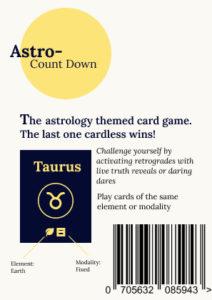
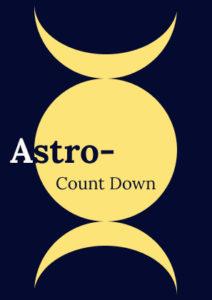
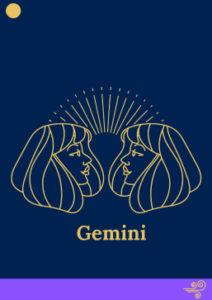



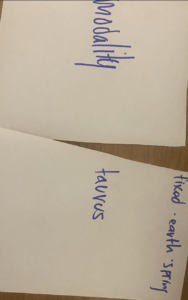
Prototypes from Box, final, third, picture of finals printed, second, and first.
Artist Statement:
Astro Count Down is an astrology-based card game. It uses elements of fellowship and challenge. The fellowship aspect is a player v player model where everyone is playing against everyone, and although collaboration between players is not integrated explicitly, players tended to collaborate to prevent one person from winning. It is as much as a card game and the challenge stems from having to form a strategy. Astro Countdown can be played with a group of people that don’t necessarily have to know each other to play. The target demographic for this game is teenage girls who are interested in astrology. I was incredibly inspired by apps like Co-Star and games like Crazy 8 and Uno for this game. This game appeals to them because the theme and special rules of the game draw inspiration from astrology and how the stars affect aspects of daily life. The game uses elemental: earth, air, fire, and water and modality: cardinal, mutable, and fixed to determine which card can be played next and there are elements like the moon and retrogrades that apply specialty events in the game. Astro-Count Down’s goal is to not have any cards left, but the real goal of playing this game is to foster laughter, fun, friendly competition, and a pastime between friends.
Mechanics:
- Each player gets a hand of 5 cards
- The goal of this game is to get rid of all 5 cards by placing cards down that are either the same element or modality of the previous card
- There are special cards that allow for skip reverse +2 and change the element or modality of the game
- Full moon
- Waxing moon
- Waning moon
- New moon
- Retrograde
- If you do not have an eligible card you must draw from the pile
- Once you run out of cards you must “consult the moon” and tap on the finished deck, if you do not and another player beats you to it then you must draw a new hand
Formal Elements
- Players: This game is meant to be played with 3-9 players. Our target audience is teenagers and college students who are into astrology. The game is more fun when you are able to connect astrological rulings over life to the game, but knowledge of astrology is not necessary to have fun. It is accessible to anyone above the age of eight. The players all have equal roles and there isn’t a game master.
- Objective: The objective of the game is to get rid of all the cards. Certain cards make it easier or harder for the other players to reach that goal.
- Outcomes: The outcome of the game is to determine a winner being the first person to finish their cards.
- Procedure: To start each player is dealt with 5 cards. The cards are completely shuffled. The first card in the deck is flipped over and the youngest player goes first, then the game goes inclockwise order. Until someone reverses the game or the first player to run out of cards goes.
- Conflict: The conflict in the game stems from the fact that the players are competing each other in this player vs player game. The objective for every player is to run out of cards. The players can collaborate with one another to ensure a different player does not run out of cards first.
- Resources: The only resource present is the deck of cards.
- Values: The value in this game is to connect people. There aren’t any prerequisites to play this game or any requirements that are exceptionally vulnerable. The game requires players’ attention, but as can be seen in the video they can still hold a conversation. The main value of this game is to promote fellowship and a small bit of challenge overcome by strategy.
Iterations: This game has playtested a total of three times before the video,
The first time was with a couple of people in my dorm. We played amongst four players. We played it with three key features: modality, season, or element. The first person to go chose one of these functions to play by, and players could switch the rule by using special cards. The game also required characters to challenge one another.
However, this was confusing because there were too many icons per card. The players liked the challenge aspect and we played a total of three rounds.
The second play test happened in class. It was played by four players. The play test determined that icons and color coding might be something the game benefits from. The playtest also determined that the game inspired friendly rivalry. However, there were still confusing elements, such as the challenges to activating the specialty cards felt like it dragged on the game too long and were not entirely relevant to the astrology theme.
The third playtest happened at my dorm again, this time with five players. We tried to adjust the challenge element in order so that there was a separate deck with predetermined challenges that follow the prompt (the moon is in retrograde today you must relieve some universal karma by sharing a secret) However, this was not as fun for players because they did not feel comfortable revealing true vulnerabilities. The gameplay otherwise for the game went well and by the second round, every player knew the rules.
The last playtest, the one recorded was played without the challenge element, and it went the smoothest. We had four players test. It was briefer than the other games, but it seemed fun. Had I had more time for user testing I would have tried to scope a balance for challenges because I felt like they made the game more challenging and interesting and astrologically relevant.
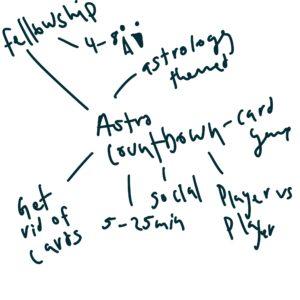
Youtube video: https://youtu.be/6ZnnmSSwQjE
Link to cards and Rules:
Image Credit for zodiacs: Canva
Software used: Figma


